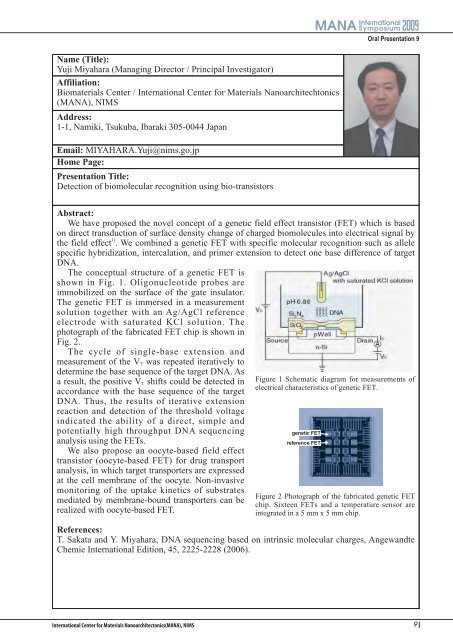Abstract Download (8.38MB)
Abstract Download (8.38MB)
Abstract Download (8.38MB)
Create successful ePaper yourself
Turn your PDF publications into a flip-book with our unique Google optimized e-Paper software.
Name (Title):<br />
Yuji Miyahara (Managing Director / Principal Investigator)<br />
Affiliation:<br />
Biomaterials Center / International Center for Materials Nanoarchitechtonics<br />
(MANA), NIMS<br />
Address:<br />
1-1, Namiki, Tsukuba, Ibaraki 305-0044 Japan<br />
Email: MIYAHARA.Yuji@nims.go.jp<br />
Home Page:<br />
Presentation Title:<br />
Detection of biomolecular recognition using bio-transistors<br />
<strong>Abstract</strong>:<br />
We have proposed the novel concept of a genetic field effect transistor (FET) which is based<br />
on direct transduction of surface density change of charged biomolecules into electrical signal by<br />
the field effect 1) . We combined a genetic FET with specific molecular recognition such as allele<br />
specific hybridization, intercalation, and primer extension to detect one base difference of target<br />
DNA.<br />
The conceptual structure of a genetic FET is<br />
shown in Fig. 1. Oligonucleotide probes are<br />
immobilized on the surface of the gate insulator.<br />
The genetic FET is immersed in a measurement<br />
solution together with an Ag/AgCl reference<br />
electrode with saturated KCl solution. The<br />
photograph of the fabricated FET chip is shown in<br />
Fig. 2.<br />
The cycle of single-base extension and<br />
measurement of the VT was repeated iteratively to<br />
determine the base sequence of the target DNA. As<br />
a result, the positive VT shifts could be detected in<br />
accordance with the base sequence of the target<br />
DNA. Thus, the results of iterative extension<br />
reaction and detection of the threshold voltage<br />
indicated the ability of a direct, simple and<br />
potentially high throughput DNA sequencing<br />
analysis using the FETs.<br />
We also propose an oocyte-based field effect<br />
transistor (oocyte-based FET) for drug transport<br />
analysis, in which target transporters are expressed<br />
at the cell membrane of the oocyte. Non-invasive<br />
monitoring of the uptake kinetics of substrates<br />
mediated by membrane-bound transporters can be<br />
realized with oocyte-based FET.<br />
Oral Presentation 9<br />
Figure 1 Schematic diagram for measurements of<br />
electrical characteristics of genetic FET.<br />
Figure 2 Photograph of the fabricated genetic FET<br />
chip. Sixteen FETs and a temperature sensor are<br />
integrated in a 5 mm x 5 mm chip.<br />
References:<br />
T. Sakata and Y. Miyahara, DNA sequencing based on intrinsic molecular charges, Angewandte<br />
Chemie International Edition, 45, 2225-2228 (2006).<br />
9















